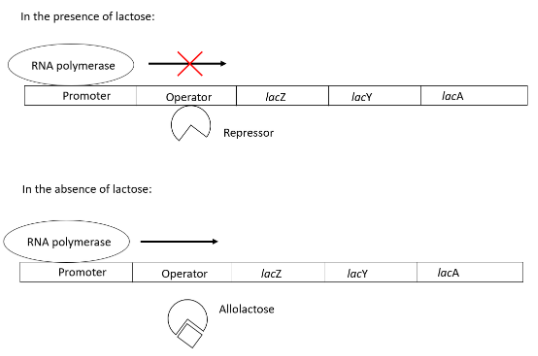
Explain how a polycistronic gene structural gene is regulated by a common promoter and a combination of regulatory genes in lac-operon.
Answer
457.8k+ views
Hint: Polycistronic mRNA code for several proteins. The gene contains an intercistronic gene followed by another cistron. During post transcriptional modification, these regions are spliced to form a polycistronic mRNA. A classic example of such genes is the lac operon which contains a cluster of genes that help bacteria grow in a lactose enriched medium.
Complete answer:
The lac operon consists of the promoter(p) region to which the RNA polymerase binds, an operator(o) region to which the repressor protein binds, and a regulatory(i) genes that produce the repressor protein along with three structural genes (z, y and a) that are involved in the metabolism of lactose.
In the absence of lactose, the lac repressor binds to the operator region blocking the transcription of the gene by RNA polymerase. When lactose is present in the medium, lactose binds to the repressor protein forming an allolactose molecule that dissociates itself from the operator region making way for the RNA polymerase which transcribes the structural genes. The polycistronic mRNA is thus formed which later gets translated to form enzymes for lactose metabolism.

Note: Hydrolysis of lactose gives glucose and galactose. Intramolecular transfer of this galactose yields allolactose which turns in the lac operon and is thus also known as the inducer molecule. It binds to the allosteric site of the repressor protein. This binding brings about a conformational change in the repressor protein allowing it to dissociate from the operator region. Once it leaves, it gives way for the RNA polymerase for the transcription of the structural genes.
Complete answer:
The lac operon consists of the promoter(p) region to which the RNA polymerase binds, an operator(o) region to which the repressor protein binds, and a regulatory(i) genes that produce the repressor protein along with three structural genes (z, y and a) that are involved in the metabolism of lactose.
In the absence of lactose, the lac repressor binds to the operator region blocking the transcription of the gene by RNA polymerase. When lactose is present in the medium, lactose binds to the repressor protein forming an allolactose molecule that dissociates itself from the operator region making way for the RNA polymerase which transcribes the structural genes. The polycistronic mRNA is thus formed which later gets translated to form enzymes for lactose metabolism.

Note: Hydrolysis of lactose gives glucose and galactose. Intramolecular transfer of this galactose yields allolactose which turns in the lac operon and is thus also known as the inducer molecule. It binds to the allosteric site of the repressor protein. This binding brings about a conformational change in the repressor protein allowing it to dissociate from the operator region. Once it leaves, it gives way for the RNA polymerase for the transcription of the structural genes.
Recently Updated Pages
Using the following information to help you answer class 12 chemistry CBSE

Full Form of IASDMIPSIFSIRSPOLICE class 7 social science CBSE

In case of conflict between fundamental rights of citizens class 7 social science CBSE

Can anyone list 10 advantages and disadvantages of friction

What are the Components of Financial System?

Complete the letter given below written to your Principal class null english null

Trending doubts
Show variation of resistivity of copper as a function class 12 physics CBSE

Electrolysis of dilute H2SO4 generates H2S2O8 What class 12 chemistry CBSE

Explain with a neat labelled diagram the TS of mammalian class 12 biology CBSE

How do you convert from joules to electron volts class 12 physics CBSE

A convex lens is placed in water Its focal length A class 12 physics CBSE

Distinguish between asexual and sexual reproduction class 12 biology CBSE




